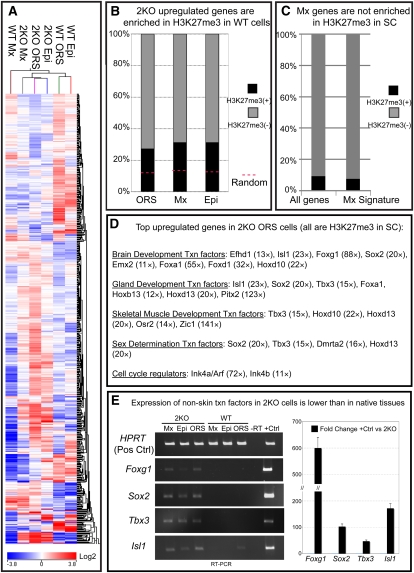Figure 5.
Ablation of Ezh1/2 leads to the up-regulation of a common subset of genes in three different skin progenitors irrespective of their lineage and response to deregulation of PcG-mediated repression. (A) Heat map and clustering analyses reveal that many genes differentially expressed in double-knockout progenitors of ORS, matrix (Mx), and epidermis (Epi) cocluster together. Notably, genes up-regulated in double-knockout ORS progenitors do not cocluster with wild-type matrix or wild-type epidermis cells, indicating that double-knockout progenitors are not induced to progress toward HF (matrix) or epidermal lineages. (B) The Ezh1/2 up-regulated genes of each skin progenitor type was compared against ChIP-seq data mapping H3K27me3 (PcG-repressive) and H3K79me2 (active transcription) marks in the chromatin of postnatal bulge SCs, matrix TA cells, or epidermal basal progenitors. Whole-scale comparative analysis reveals that one-third of genes up-regulated in double-knockout ORS, matrix, or epidermis are targeted by H3K27me3 repression in wild-type progenitors. (C) Genes that are normally activated in wild-type matrix cells are not preferentially repressed by H3K27me3 histone mark in SCs, explaining why genes controlling matrix lineage determination are not preferentially up-regulated when H3K27me3 marks are removed from ORS stem cell progenitors. (D) Top up-regulated genes in double-knockout ORS cells that are regulated by H3K27me3 in wild-type ORS bulge SCs. Fold up-regulation is given in parentheses. (E) Real-time PCR reveals that ectopic activation of genes encoding nonskin lineage transcription factors in all three skin progenitors is significantly lower compared with their levels within native tissues (+Ctrl). Quantifications are shown at right.

